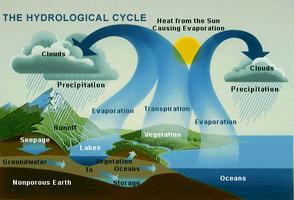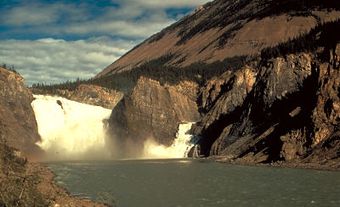
Water
Water (H2O) occurs in the atmosphere and above and below the Earth's surface as a liquid, solid or gas. It is continually changing state (eg, by freezing/thawing or evaporation/condensation) and location (eg, gaseous, liquid or GLACIER flow). All water is involved in a continuous hydrologic cycle, of which evaporation into the atmosphere from oceans, lakes, rivers and land surfaces and transpiration through plant leaves may be considered the first phase. This moisture is transported, often great distances, by winds and is precipitated, as RAIN or SNOW, upon water and land surfaces.Worldwide, over two-thirds of precipitation falling on land surfaces is evaporated and transpired back into the atmosphere. In Canada less than 40% is evaporated and transpired; the remainder, called the water yield, enters into streamflow. In the drier plains, only 10-20 mm of the 300-400 mm of precipitation enters streamflow, largely from drift snowmelt and from heavy rains in some years. In west-facing coastal ranges of the West Coast, where annual precipitation is 3000-7500 mm, approximately 300-600 mm is evaporated and transpired, and 80-95% runs off. In far northern areas where little heat is available, only 100-200 mm is evaporated or transpired and 100-500 mm enters streamflow.
The proportion of runoff increases in rocky, paved, fallow and elevated (cooler) areas, where there is little moisture storage, vegetative cover or heat for much evapotranspiration. Small coastal and mountain areas in the West have very high yields; larger areas in the East and in parts of the North have moderately high yields; lower yields occur in the southern plains and in some interior valleys of the western Cordillera.
Water may be drawn for use from rivers, lakes and groundwater supplies. It may also be put to uses (eg, HYDROELECTRICITY, fishing, navigation, recreation and wildlife habitat), which involve little consumption of water. Canada is fortunate in having relatively abundant supplies. Withdrawal uses involve only 1.8% of the total; consumptive uses only 0.2%. We are in no danger of running out of water, although there are regional deficiencies and problems of quality. Partly because of these abundant supplies, flooding and drainage problems are relatively large.
Canada's history is closely related to LAKE and RIVER use. Exploration and development were largely along water TRANSPORTATION routes, and the early FUR and TIMBER trades were river oriented. Water transport dominated early commerce. With CANAL development, bulk movement far into the continent became possible, and canal transportation remains very important today (especially in the St Lawrence-Great Lakes Basin). Farm IRRIGATION was and is a major factor in agricultural development in the drier southwestern plains of the Prairie Provinces and the southern interior of BC, and supplemental irrigation is expanding into more humid areas (southern Manitoba and Ontario). Water power and, later, hydroelectric site developments were major bases for industrial development. Urban and industrial demands have grown rapidly and most cities and industries are river and lake oriented.
Commercial and recreational fishing are significant, but WATER POLLUTION, DAMS and other man-made changes have had largely negative effects on these activities. Wildlife and recreational demands are important and have also suffered from human activities. Environmental enhancement is possible but not widely undertaken, even to compensate for damage done. Water conservation measures are not yet widely employed, but the growing costs of obtaining high-quality water and avoiding stream water pollution are resulting in an increased recycling of water.
It's The Secret Life of Canada's first shout out to a living youth leader! Meet Anishnabe-kwe Autumn Peltier. Greatly influenced by her great aunt Josephine Mandamin, Autumn has been using her voice to advocate for water rights since she was 8 years old. Today, The Secret Life of Canada learns a little more about this phenomenal water warrior and International Children’s Peace Prize nominee.Note: The Secret Life of Canada is hosted and written by Falen Johnson and Leah Simone Bowen and is a CBC original podcast independent of The Canadian Encyclopedia.
Provincial Profiles
Water supply and demand patterns vary greatly from province to province. The water supply available in each province is made up of that of local origin plus part of that flowing from other provinces and states, less part of that flowing to other provinces and states.
British Columbia
British Columbia has the greatest flow, half coming from the one-sixth of the province's area occupied by the Coast and Island mountain ranges. Some interior valleys are very dry, but surpluses from adjoining mountain areas can be used for irrigation and other purposes. For the province as a whole, supply exceeds consumptive use by over 1600 times, but water shortages are present locally. The major conflicts are between nonwithdrawal users such as hydroelectric developments and salmon fisheries. To protect the salmon industry, dam development has not proceeded on some rivers (eg, lower and middle FRASER). Pollution is a growing problem and the costs of control are now a major part of pulp and paper and mineral development.
Alberta
Alberta, with only 2% of the supply, in drier years has over 50% of the consumptive use demand for Canada. Well over half of Canada's irrigated land and most of the secondary recovery of oil and natural gas (involving the pumping of water into the geological formations to replace these fuels) are in Alberta. Substantial expansion of BITUMEN development, involving evaporation of large quantities of water from tailings ponds, might increase Alberta's share of Canadian consumptive demand. The problem is accentuated since almost all of the irrigation, urban and industrial demand and some of the mining demand is in southern Alberta, while most (87%) of the water supply is in the north (Arctic rather than Hudson Bay or Gulf of Mexico drainages). Moreover, by agreement with the governments of Saskatchewan, Manitoba and Canada, one-half of the southern flow is allocated to downstream use. In the near future, dry-year demand may exceed supply, and political pressure for greater storage and interbasin transfers will grow.
Saskatchewan
Saskatchewan, with much less irrigation and oil, is trying to expand with a limited water supply in the south. POTASH mining demands are large, and mines and municipalities are served increasingly by canal and pipeline systems. Quality issues in the QU'APPELLE RIVER Valley are as acute as anywhere in Canada, largely because there is so little flow to assimilate and dilute wastes. Tertiary treatment of municipal wastes in the southern plains is relatively advanced. Thermal and hydroelectric power alternatives are varied, and environmental concerns and multiple-use management are well developed. Prairie sloughs, which are part of a major migratory waterfowl habitat, need protection and enhancement.
Manitoba
Hydroelectric power has been dominant in water planning for the province, but drainage, flood damage limitation and a significant potential for irrigation development are of strong interest. The supply issue is less critical, partly because of the large amount of water that flows into southern Manitoba from the west, east and south. Environmental issues are prominent, including some relating to the Garrison Project development in North Dakota and the possible dumping of saline waters or southern fish and other organisms into the province's rivers and lakes.
Ontario
Ontario had long considered its water resources to be unlimited and indestructible. They are abundant, but by the 1960s it had become apparent that river and lake water quality had been severely damaged by industrial, municipal and other pollutants. The GREAT LAKES and connecting rivers had received more pollution from the more populous and highly industrialized American side than from Canadian sources, and joint programs for reducing pollution were instituted. Ontario is coping (in large part) with the problem through tertiary treatment of most municipal and industrial waste; through the use of multiple-purpose development for withdrawal and on-stream uses and for river control; and through river-basin management, including the institution of conservation measures.
Supplemental irrigation in dry periods is becoming more widespread for tobacco fields, orchards and market gardens, where quality control as well as yield increase is important. Urban and industrial uses are large, but most of the water used for washing, cooling and other purposes is returned to streams. Thermal power plant (coal and nuclear based) return flow is potentially damaging to fish, but this heated water can also be a resource. Consumptive use is small and water shortages are largely quality related.
Québec
Québec has abundant supplies and a long history of water use. Nonwithdrawal uses (eg, hydroelectric power, navigation, fishing and recreation) are very important. Urban and industrial use is large and there has tended to be a greater reliance upon the natural assimilative capacities of streams in waste disposal than there has been in most parts of Canada. Waste treatment is needed and is slowly being instituted. The hydroelectric power potential has been large and, with development in northern basins (eg, MANICOUAGAN and LA GRANDE Rivière), over half of it has been realized. Navigation on the ST LAWRENCE is limited by ice in winter, but the shipping season is being extended, especially for downstream ports. Drainage for agricultural development is widespread and some drainage for forest site improvement is under way. Flooding is a problem, especially in spring when snowmelt supplies are augmented by heavy rains.
Atlantic Provinces
The Atlantic provinces are relatively humid with little need for irrigation. Problems of flooding and drainage relating to seasonal oversupply are more common. Water yields are high and rivers are large, relative to basin areas. Waterpower, followed by hydroelectric power, has long been a basis for industry. Recreational and commercial fishing, navigation (limited by sea ice in most winters and most areas) and some withdrawal uses are significant. Pollution is a problem, but streams, tides and coastal ocean currents have been used to dilute and assimilate wastes and the problem is not as acute as in some water-short areas.
Territories
The measurement data of the last few decades in the Yukon, Nunavut and the Northwest Territories are for much larger rivers than might be expected to be present with the limited precipitation recorded. This may be the result of unrepresentative precipitation records (the settlement stations are in the drier areas); furthermore, gauge undercatch is normal, especially for blowing snow. With low evapotranspiration, the greater part of the precipitation enters streamflow. Many of the problems of water use relate to frost and PERMAFROST and some communities have insulated corridors for water and sewage. River navigation is still very important; actual hydroelectric power development represents only a small part of the potential and withdrawal uses are small. Recreational uses are growing and wildlife concerns are of growing importance.
Interbasin Transfer Southward
With increasing competition for limited supplies of pure water, the need for integrated multiple-purpose management and for conservation will grow. Canadian pressure upon supply is much less than in the US, where the total supply for the coterminous 48 states is only 40% as large as that of Canada (70% with Alaska). Withdrawal demand in 1995 was about 25% of the supply, consumptive demand was over 7%, and much more of the supply was polluted to varying degrees. Regional shortages are much greater than in Canada, but the demand for interbasin transfers from Canada will continue to be negligible for many decades.
There are cheaper alternative supplies in the US; costs of transfer would exceed the value of most products that might be produced; the willingness to subsidize irrigation is declining; and the political, legal, environmental and other problems would be formidable. In the future there could be some transfer, but only if mutually beneficial arrangements, with environmental enhancement at least equalling the minimal damage required, can be worked out. Irrigation is one of the less likely recipients because it is a low-return use, unable to cover the costs of major transfer, and greater increases in agricultural production can be obtained by other cheaper means.

 Share on Facebook
Share on Facebook Share on X
Share on X Share by Email
Share by Email Share on Google Classroom
Share on Google Classroom


